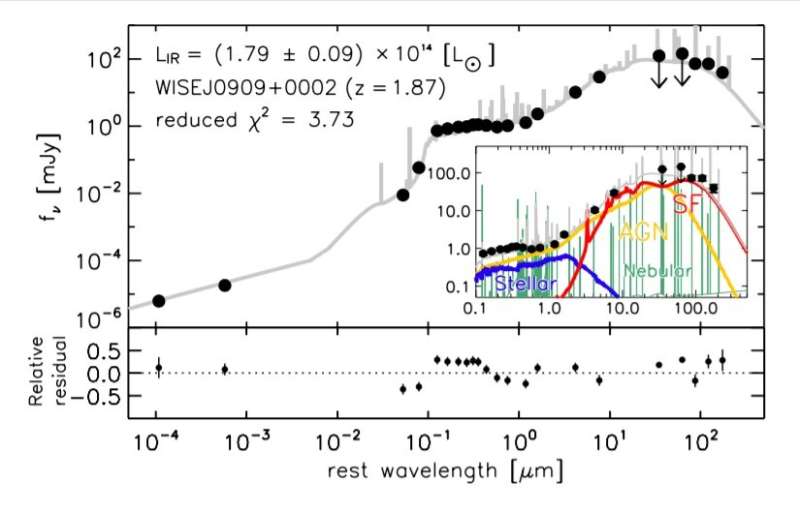The best-fit SED of WISEJ0909+0002. Credit: Toba et al., 2021.
An international team of astronomers has investigated an extremely luminous infrared galaxy known as WISEJ090924.01+000211.1 (or WISEJ0909+0002 for short) as part of the eROSITA final equatorial depth survey (eFEDS). Results of this study, published April 6 on the arXiv pre-print server, provide important insights into the properties of this galaxy.
Luminous infrared galaxies (LIRGs) are galaxies emitting more energy in the infrared portion of the spectrum, with luminosities above 100 billion solar luminosities. LIRGs with luminosities exceeding 100 trillion solar luminosities are known as extremely luminous infrared galaxies (ELIRGs).
The infrared luminosity of ELIRGs is assumed to be produced by star formation, active galactic nucleus (AGN) activity, or both. Hence, studies of ELIRGs could shed more light on the process of galaxy formation and evolution. They could also provide more insights about the connection of these galaxies to their supermassive black holes (SMBHs).
WISEJ0909+0002 was first detected as an ELIRG candidate at a redshift of 1.87 using the eROSITA X-ray instrument onboard the Spektr-RG spacecraft. Recently, by analyzing data from eFEDS, a team of astronomers led by Yoshiki Toba of the Kyoto University in Japan has confirmed the ELIRG status of WISEJ0909+0002 and learned essential information about the nature of this object. The study was complemented by archival data from NASA's Chandra and ESA's XMM-Newton spacecraft.
The results indicate that WISEJ0909+0002 has an infrared luminosity of about 179 trillion solar luminosities. This was derived from spectral energy distribution (SED) modeling based on photometric data and confirms that this galaxy is an ELIRG.
According to the paper, WISEJ0909+0002 is a very luminous unobscured type-1 active galactic nucleus (AGN). The photon index, hydrogen column density, and absorption-corrected hard X-ray luminosity in the rest frame 2–10 keV were found to be 1.73, less than 21.0, and approximately 2.1 quattuordecillion erg/s. These values are typical for luminous unobscured type-1 AGNs.
The astronomers noted that the relatively low hydrogen column density of WISEJ0909+0002 is surprising given its extraordinary infrared luminosity. It may suggest that this ELIRG is embedded within a large amount of gas and dust. All in all, the observed properties of WISEJ0909+0002 seem to indicate that we are witnessing a short-lived ELIRG phase in the course of galactic evolution of this source.
"A remarkably high LIR despite very low NH would indicate that we are witnessing a short-lived phase in which hydrogen gas along the line of sight is blown outwards, whereas warm and hot dust heated by AGNs still exist," the researchers concluded.
The study also revealed that WISEJ0909+0002 has a mass of nearly 500 billion solar masses, while the mass of its supermassive black hole is estimated to be at a level of some 7.4 billion solar masses. The star-formation rate of this galaxy was calculated to be around 3,850 solar masses per year.
More information: The eROSITA Final Equatorial-Depth Survey (eFEDS): An X-ray bright, extremely luminous infrared galaxy at z = 1.87, arXiv:2104.02462 [astro-ph.GA] arxiv.org/abs/2104.02462
© 2021 Science X Network
























